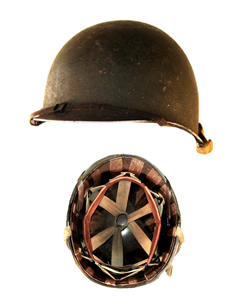M1 HELMET AND LINER

The M1 helmet, affectionately known as the "steel pot," was a versatile piece of headgear. Veterans claim to have used it as a washbasin, a bucket, a cooking pot, and some say even a toilet. One would hope that it was cleaned out pretty well after that! Of all the myths surrounding the M1 the cooking pot and toilet seem the least sensible. Putting the helmet in a cooking fire could ruin its heat treatment and diminish its protective qualities. As for the use of the helmet as a toilet, there is an old expression that goes, "You donât shit where you eat."
When buying an M1 helmet, look for one with the chin-strap sewn onto the D rings. Either khaki or OD chin-straps are good as long as they are SEWN on. Later chins-traps were attached to the helmets with steel clips. Avoid these. For what you will have to pay for a replacement chin-strap, if you can find one, you might as well buy the helmet with the correct sewn on type.
There are only two types of hooks for connecting the chin-strap. The early type is made of bent brass or steel wire. The later and more substantial type hook is made of flat stamped out springy steel.
There are two type of D rings on M1 helmets. The early type is a rectangular bent wire welded directly to the helmet making it inflexible and subsequently prone to breakage. The later type is attached the helmet with a sheet metal bracket that allows it to fold in or out. The later is more common but both are acceptable.
The W.W.II era liner for the M1 helmet is substantially different from later styles. They are thinner than the more recent types and the resin impregnated cloth they are laminated with is brown to brownish green while the modern, incorrect type, is green or yellowish green.
The support webbing also differentiates the W.W.II liner from later types. There are two web assemblies riveted inside. One consists of a headband to support the clip-in sweatband and three triangles whose points meet in the crown of the liner where they are tied together with a separate loop of narrow fabric tape to adjust the depth of the liner. The height of the crown is adjusted by increasing or decreasing the circumference of that fabric tape loop. The other web assembly is simpler, consisting of a band that crosses the back of the neck below the skull. A shorter web neck strap, sometimes adjustable, snaps onto it to keep the helmet from falling forward over the face. All of the webbing in the liner is the same width and it is always a herringbone twill (HBT) though the color can be khaki or OD.
The liner has a single grommet hole in the front and two blackened brass nipples on the inside. One at each temple. All W.W.II liners had these chin-strap fittings. This is for fitting liner's leather chin-strap which is leather with an blackened brass adjuster clip, and a spring clip on each end to attach it to the nipples..
Any sweatband for an M1 helmet will snap into your liner. A modern one won't be on Khaki HBT webbing. For that reason some people simply buy a modern one, strip the leather off of it and sew it to their worn out HBT W.W.II one. It is a simple project that is easily done on a light home sewing machine.